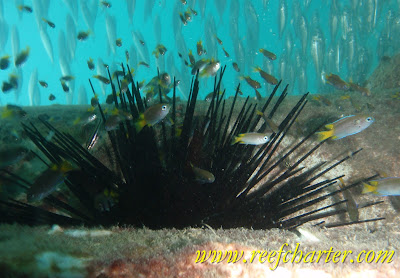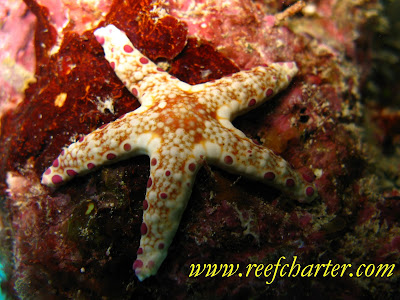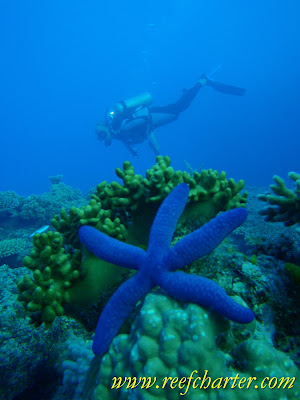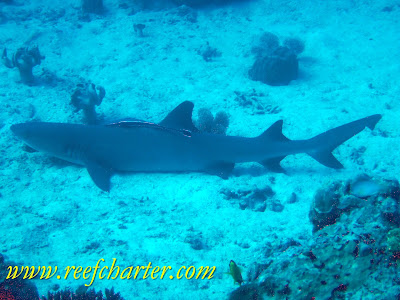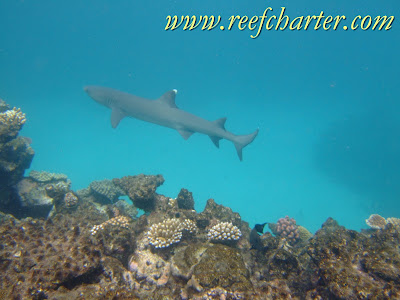The sea urchin is a common site in aquariums and reefs around the world, and the Great Barrier Reef is no different. They abound on the shallows of the reef as well as the deeper areas and walls. Sea urchins are related to sea cucumbers and starfish. Like their cousins they have tubular feet they use to crawl across the reef. They use both water and blood as circulation systems in their bodies and eat mostly algae as part of their diet. When food conditions abound they can reproduce very quickly and therefore reach large numbers in a very short period of time. Likewise when the food sources dwindle they die of in masses just as quickly.
The spines are method of protection against predators but also offers a home to juveniles of smaller fish, offering them protection also. These spines are not dangerous to humans but as always it is best not not play with the wildlife.
Category: Species-of-the-Reef
Starfish Facts – Species of the Reef
When people think of starfish they think of the typical five armed creature as pictured above and that is correct for the majority of species. But the species is very diverse and starfish can have anything up to 50 arms and come in a large variety of shapes as shown by the feather stars on a previous post. There are so many beautiful members of this family that you can see while you visit the Great Barrier Reef.
The starfish uses water to propel itself. Yes you thought that it used all those little “legs” with suction caps to move along. Well they do and they use water taken in through their body to provide suction to those “legs”. This helps the starfish to appear to float or glide across the surface of the water.
Starfish generally eat their food whole and use their stomachs to digest their food. They eat just about anything they can find on the reef including clams, fish, molluscs, small fish, coral and algae. They can also digest food outside their body by excreting their stomachs allowing them to eat creatures much largers then they could through their mouth.
Sea stars have endoskeletons. The top of the starfish is sensitive to light and the bottom of the starfish is sensitive to different chemical compositions allowing them to “smell” food. Another cool fact is the starfish breathes through it’s feet.
Starfish breed a lot depending on species. The can be hermaphrodites, capable of sexual and asexual reproduction, some are born males and later change into females. One common fact is you cannot tell the difference between the male and females unless you see them during spawning. Reproductive organs are contained within the starfish.
White Tip Reef Shark – Species of the Reef
This is the most common shark spotted by our guests, whether they are snorkeling or scuba diving. The white tip reef shark is a relatively small shark. The average size only measuring about 1.8 metres or 6 feet long. This is one of the best parts of our jobs, seeing people who less then 30 minutes ago were scared about sharing the water with a shark. Now they are seeing them up close and experiencing sharks in their natural habit. Immediately realizing that all the television and movie myths are just that myths. One of our guests last year went from being a nervous snorkeller to scuba diving, and her reason I want to ‘dive with the sharks’.
As you can see from the photo above, all sharks do not require to keep swimming to stay alive, this again is another myth. White Tip Sharks can move water through their gills as they lay still on the bottom. This species of shark tends to hang around reefs for long periods of time, sometimes years. They hunt at night feeding on octopus, fish and other reef creatures, including lobsters and crabs. Not a bad diet. During a night dive, you can observe them slowly swimming along the reef edge looking for that evening snack. Unlike other shark species they do not get into a feeding frenzy.
They are not aggressive towards humans at all, unless provoked and then purely a defensive measure. Humans feeding sharks can lead to confusion and sharks may mistakenly grab the hand that feeds it. Another good reason not to feed the fish, especially the big ones with big teeth.
White Tip Sharks pregnancy lasts about 10-12 months. They give birth to young called pups, this litter can contain anything up to 6 pups. Now how did the white tip shark get its name? Very easy, the white tips on the tops of the fins.
Current populations of white tip sharks are depleting at the rate of about 8% per year, due to unsustainable fishing practices in other parts of the world and its slow reproductive rate.
Swimming and diving with sharks that you must experience to really appreciate. The only way to dispel the myths and see the grace and beauty of a shark it to come and experience it in the sharks natural habitat.
How Does a Coral Reef Form?
We even have a picture with labels today, don’t get used to it. This is courtesy of Fiona please see the credits below.
A coral reef is an accumulation of the limestone skeletons of dead reef organisms and the algae that glues them together.
The coral reef builds upwards, growing towards the light much like trees in a rainforest, competing for space and light. Once the coral reef reaches sea level it cannot survive the harsh surface conditions so begins to grow outwards. Creating spectacular formations of coral that spawn further growth and spreading of the reef ecosystem.
Through time, animals grow and the sand, rubble and debris of life is broken down by waves and eroding animals, such as worms and sponges. A complex reef ecosystem is built over time. Today’s underwater gullies and caves were formed because of that erosion. These are the same formations scuba divers enjoy exploring today because they are shelters for an abundance of marine life.
Coral reefs tend to grow where there is a lot of water movement, bringing nutrients, oxygen and new species. Most reef-building corals cannot grow in waters shallow enough to expose them at high tide or deeper than 50 metres, making them highly sensitive to changing sea levels.
The Reef is continually evolving and changing as climate and sea levels change. Healthy, diverse reef ecosystems are more resilient, that is, they are able to adapt to change. The Great Barrier Reef Marine Park Authority is concentrating on maximising reef resilience through research and management.
Thanks to Fiona Merida for this great information. Fiona currently runs the Eye on the Reef Program for the Great Barrier Marine Park Authority. A very successful program that brings together and unites the Great Barrier Reef Marine Park Authority, the Great Barrier Reef tourism industry and the reef research community for the greater good of protecting the reef and educating the community.
